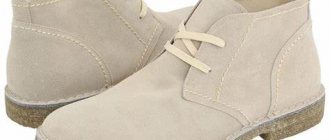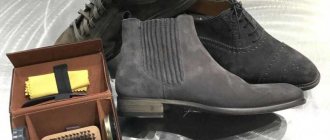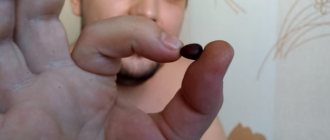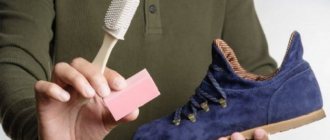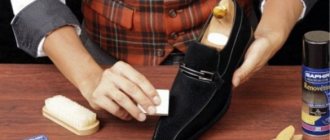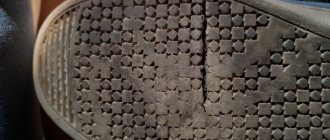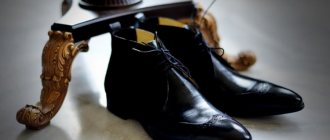Suede shoes look very beautiful and expensive, but require careful care and careful wearing. Shoe repair shops offer shoe polishing using a variety of oils and lubricants. This procedure is called arbitration and costs a lot of money. But you can also restore suede shoes at home using special products. Before you start working on improving the appearance of your shoes, you should know how to do it correctly to get the desired effect.
How to update your shoes?
Many lovers of suede shoes have to give them up, because ladies often do not know the simple rules of care. The main requirement is that you should not wear shoes made of delicate material in bad weather, as it is necessary to limit contact with water as much as possible.
The remaining rules are divided into three subgroups: drying, storage and care products. It is important to correctly follow each rule, then you will not have problems with your favorite shoes or sneakers. It is recommended to arrange your shoes regularly to avoid problems later. If the matter has already started, then the cleaning will take place in several stages.
How to seal it
Owners of suede shoes know that suede is a rather delicate material. If you don't take care of it, it can burst, crack, and tear. In this case, the defect can be eliminated using glue, but not all types of glue are suitable.
The most common mistake made by those who decide to glue suede shoes on their own is the use of PVA glue. Excellent at gluing paper, it is completely unsuitable for shoe repair because it has too weak a concentration. In addition, PVA is made on a water basis, so during the first walk the part glued with it will fall off under the influence of moisture.
The same recommendations apply to Moment glue. It is good if you need to glue some hard parts (for example, metal, wood or glass) during construction work. However, it has a destructive effect on suede. The fact is that when it hardens, it becomes very hard. For example, the toe of a boot glued in this way will soon begin to burst.
Ultimately, you have to go to a shoemaker and pay extra money to restore the shoes, since repairing them after such repairs will require much more effort.
Therefore, if you decide to glue sneakers, shoes or other shoes at home yourself, it is better not to save money by using improvised means, but to purchase special shoe glue.
A small tube will be enough for you, since the need to glue something on your shoes does not arise very often.
Care tools
To restore suede and return it to its previous appearance, you can use the following available means: An elastic band can be office or special for suede; it lifts the pile and promotes better color rendition. Special sprays are available in two versions: for painting and for protection. The first helps return the boots to their original appearance by painting them in the desired color. The most popular is black, but shades of blue and brown are also available. The protectant acts as a water-repellent agent; the colorless spray creates an invisible thin layer on the surface that prevents the penetration of moisture.
Brushes vary in material and hair type. They can be metal, rubber or polymer. The first one copes well with old, worn-out shoes. The second two are intended for resuscitation of new shoes. All brushes lift the print, giving it a fresher look, while also cleaning it of all types of dirt.
For DIY enthusiasts, suede shoes may require gradual restoration, and other items may also be required. For example, baby soap, baking soda, milk fat, semolina, ethyl alcohol, ammonia, baby powder, a piece of soft cloth, a sponge, magnesium and turpentine. All of the above products help solve one problem or another.
Step-by-step cleansing
Resuscitation of suede takes place in several stages. If all the rules are followed correctly, your shoes will look as if they have been dry cleaned.
The first thing to do is clean the surface of the shoe by removing dust with a soft cloth or sponge. You can also use a soft brush or school eraser to clean. If the shoes are in absolutely terrible condition, wash them with soap. Rub the sponge with laundry or baby soap, rinse lightly with water and rinse well. It is the foam that will help get rid of dirt under the pile. The surface should be carefully wiped with a sponge and then wiped with a rubber brush. It is important that the suede does not get too wet, otherwise the whole process will be in vain. If you don't have soap at home, you can replace it with shower gel or detergent.
Which brush should I use to lift suede hair?
Choose the right brush. To avoid damaging your suede, clean it only with a natural hog bristle brush, such as the Solemate Brush Premium. Iron, crepe and other rough brushes will not work. And you can “comb” suede only with a rubber brush with teeth.
Interesting materials:
How much does 1 kg of walnut cost? How much does 1 kg of goose down cost? How much does 1 kg of copper cost in Belarus? How much does 1 cubic meter of gas cost in Derbent? How much does 1 kW of light cost in the Saratov region? How much does 1 minute cost in MTS? How much does 100 minutes of MTS cost? How much does iPhone 12 Pro Max cost in America? How much does it cost to rent apartments in Moscow City? How much does a ticket for the express train to Sheremetyevo cost?
7 easy ways to restore suede at home
“And they are still fighting for the honorary title of the House of High Culture and Life!” - Anton Semenovich Shpak said to the police dog in the immortal comedy “Ivan Vasilyevich Changes His Profession.”
This article won't tell you what to do if your suede jacket is stolen. However, you can learn how to make your suede shoes look fresh again! Let's find out how!
Suede is a very thin and delicate velvety leather that absolutely cannot withstand walking through dirt, dust or rain. At the same time, the dazzling summer sun doesn’t suit him either! So how do you take care of such painstaking material?
5 steps to care for suede:
- after each exit, clean your shoes with a special brush;
- if the brush does not help, use a special eraser;
- Remove stubborn dirt using special foam for suede;
- use special gels and sprays to protect against contamination;
- The color will be restored by suede paint.
What to do if suede has lost its original color?
Sometimes, even with good care, suede shoes fade in the sun. Color brightness also decreases with prolonged use. There are several ways to restore the original color and refresh suede products:
- Special coloring spray. The shade of paint should match the color of the shoes. This paint can be purchased at shoe stores or in the household chemicals department. It must be used strictly in accordance with the instructions. Before painting, it is important to cover the floor or other surface on which the shoes will sit.
- Ground coffee. Shoes of dark shades can be treated with brewed natural coffee. The prepared drink must be filtered through a strainer. Pour the liquid into a spray bottle and spray over the suede surface. After 20 hours, the solution will be completely absorbed. If the color is not saturated enough, you can repeat the coloring.
- Soda and milk. A product made from 0.5 cups of skim milk and 0.5 tsp will help refresh the color. soda ash. The solution is applied to faded areas.
- Marker. You can return the black color using a regular marker. It is better to take waterproof markers so that the paint does not wash out again.
How to renew suede at home?
If the suede feels unkempt when worn and you don’t want to spend the money on refinishing it at the dry cleaners, then you can use at-home methods for updating suede. What will you need? The following countermeasures are required:
- cheap laundry soap;
- baking soda;
- full fat milk;
- semolina;
- ethanol (you can use kerosene);
- ammonia solution;
- wire brush;
- suede care products;
- dry rag;
- talc or baby powder;
- sponge;
- magnesia;
- turpentine.
Step 1. Make your shoes clean again
Remove dust and dirt from suede with a dry sponge or a special brush for suede (you can also use a branded eraser or a regular school eraser for suede).
If your shoes are in poor condition, clean them with soap and water. To do this, wipe the sponge with laundry soap, slightly moisten it and lather thoroughly. In this case, the cleaning agent is foam. Apply it to the suede and scrub with a brush. Avoid getting the material excessively wet!
Or you can use laundry detergent or other detergent instead of soap.
Step 2: Remove stains
Semolina can help remove stubborn debris. To do this, sprinkle the stain with semolina, and then gently scrub with a wire brush.
Tip: the easiest way is to “steam” suede over a boiling kettle (near the spout). A saucepan cannot be used because the total water surface of the steam is too large. You might get burned!
Step 3. Fat stains
To remove greasy streaks, sprinkle the stained area with talcum powder and leave for a quarter of an hour. Shake the remaining talcum powder. Dampen a dry cloth with alcohol or kerosene, and then wipe the dirty area (above the talcum powder). The procedure should end with standard shoe cleaning with a suede brush.
Tip: Greasy streaks can be easily removed with dish soap. Apply to the stain, leave for a quarter of an hour and rinse with a damp cloth.
Step 4. Bald patches
Method 1: Suede can get rid of corns! To do this, mix soda and milk (1 teaspoon and 3 tablespoons, respectively). The resulting solution should be absorbed with a soft, dry cloth and the chest should be treated. After 5 minutes, repeat the procedure, then leave the shoes for 30 minutes.
After the time has passed, the shoes must be combed with a rubber brush.
Method 2. Ammonia and warm water will help restore the structure of suede at home. The components should be mixed in a ratio of 1: 4, and then treat the surface of the shoe. This method works well for removing old stains from suede.
Step 5. Drying
After the procedures, shoes should be thoroughly dried. To do this, fill them with unnecessary paper and let them dry naturally.
Tip: Do not use newsprint as filler as the ink may leave marks.
Step 6. Restore color
The ideal way to restore the color of suede is to use a special paint. If you don't have it in your house, you can try: coffee grounds (helps bring back the dark color); a mixture of magnesia, talc, turpentine and full-fat milk in equal proportions.
These measures should be applied to the entire surface of the shoe and left for some time. For coffee grounds it is 12 hours or a day. The milk mixture should be stored for no more than an hour. Then brush the suede with a brush and dry thoroughly.
Step 7: Post Processing
Dried shoes should be brushed again and protected with hydrophobic impregnation.
All you need is a pair of suede shoes... Three pairs.
Oily stains
Oily stains on suede shoes are more difficult to deal with; they penetrate deep into the leather structure, which complicates care. However, there are several effective ways to solve this problem at home without going to the dry cleaner.
- A small amount of tooth powder, talcum powder or starch should be heated in a frying pan and poured onto the affected area. Place a napkin or other porous paper folded in several layers on top and press it against the shoes with something heavy for 2–3 hours. The product absorbs fat, then the paper must be removed and thrown away.
- Salt heated in a frying pan must be poured into a bag or sock made of natural fabric. Apply it to the area of contamination and hold until the dirt is completely removed.
- To clean suede shoes, you can use a solution of equal parts ammonia and liquid soap diluted with a small amount of water. Blot the lint with a sponge or cloth soaked in it. After a couple of hours, the remaining solution should be washed off with a damp brush.
- Using a solution of a teaspoon of table vinegar and a liter of water, wipe the surface of the shoes until completely clean. In the same way, you can use a cotton pad soaked in a 10% alcohol solution.
- You can remove greasy stains from the surface of suede shoes with purified gasoline. We wipe off the dirt with a cloth soaked in it, then dissolve a few drops of dishwashing detergent in water and wash off the gasoline with it.
For stains of other origins, soapy liquid works well; the affected area is washed with it, then the remaining foam is removed with a sponge.
How to restore worn suede shoes
The modern market offers a wide selection of shoes. Today you can choose models from various materials to suit every taste.
Many people are attracted to suede products, but buyers are hesitant to make such a purchase, fearing difficulties in care. Dust, dirt and wet weather can take a toll on the appearance of once beautiful shoes.
The ability to clean suede shoes allows you to preserve their beauty for a long time. The main rule for caring for suede shoes and boots is timely cleaning of the surface from stains and dirt.
Before you begin repairing your suede shoes, you need to get rid of any debris. For this reason, any scuffs should be treated after all dirt and dust have been removed from the surface of the shoe, and all types of dirt, such as grease and dirt, should be removed only after it has dried.
Well, you've removed all the dirt and stains. But what to do next? How to restore suede leather to its original appearance and appearance after drying?
What is suede, and what is its artificial counterpart made from?
Suede is a natural material made from the skins of sheep, deer or goats. The raw materials are processed in a special way, resulting in thin leather with a soft, velvety surface. This material has a high degree of breathability and retains heat well. Feet in such shoes do not sweat.
An artificial suede substitute is a synthetic material made from polymer fibers. To create this material, cotton-based polyester is used. During the manufacturing process, it is impregnated with Teflon to make the base durable.
Artificial suede material is less breathable and is stiffer than natural material, but synthetic suede also has its advantages:
- resistance to fading under the influence of sunlight;
- high strength;
- variety of shades;
- lack of specific odor;
- low price of products;
- ease of care.
In appearance, the synthetic analogue is practically no different from the natural material thanks to the use of modern technologies. The main disadvantage of a synthetic substitute is its tendency to form bald spots. Over-drying makes artificial fabric brittle.
